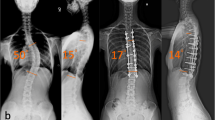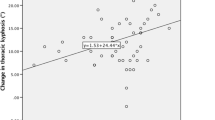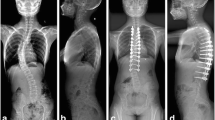Abstract
Background
Numerous studies proved that all pedicle screw constructs produce the best outcome in the surgical treatment of patients with scoliosis. However, the optimal amount and distribution of screws has not yet been defined. In recent studies on idiopathic scoliosis, the correlation between curve correction and implant density has been discussed with diversifying results.
Purpose
The aim of this study was to detect a possible correlation of sagittal and coronal curve correction in dependence of metal load and flexibility index.
Materials and methods
Twenty-six patients were included in this study with surgical correction by one surgeon between January 2014 and December 2017. Clinical data and radiographic images (preoperative, postoperative and one-year follow-up) were retrospectively analyzed and metal load, flexibility index, correction rate and correction index were consequently calculated. The Pearson correlation analysis was used for metal load—correction index and metal load—correction rate, correction of kyphosis—metal load and correction of lordosis—metal load. According to the mean metal load of 88%, patients were divided into two subgroups—a low-density group of 12 patients and a high-density group of 14 patients. Clinical and radiographic features were examined by an independent two-sided t-test.
Results
Eight patients were male, 18 patients female. Ten suffered from neuromuscular and 16 from idiopathic scoliosis. Mean age was 17.1 years. Correction rate directly postoperative was 70.43%, at the follow-up 67.90%. Mean correction index directly postoperative was 3.40 and at the follow-up 3.23. Pearson correlation of metal load—correction index directly postoperative was − 0.188 and one year postoperative − 0.189. The correlation between metal load—correction rate immediately after the surgery was 0.324 and at the follow-up 0.285. Correlation for correction of kyphosis—metal load postoperative was − 0.120 and one year later − 0.178. Pearson coefficient of lordosis—metal load directly after the surgical intervention was − 0.214 and at the follow-up − 0.220. Dependency of flexibility index and correction rate showed a positive trend (Pearson flexibility—correction rate direct 0.616; flexibility index—correction rate follow-up 0.516). A statistically significant difference between the high- and the low-density group was detected in the correction rate directly postoperative (p = 0.047).
Conclusion
With an implant density over 70%, satisfactory surgical treatment can be achieved in idiopathic and neuromuscular scoliosis. No statistical significance between the high-density (88–100%) and the low-density (73–87%) group could be verified in curve correction, ICU stay and complications.




Similar content being viewed by others
References
Shen M, Jiang H, Luo M, Wang W, Li N, Wang L, Xia L (2017) (2017) Comparison of low density and high density pedicle screw instrumentation in Lenke 1 adolescent idiopathic scoliosis. BMC Musculoskelet Disord 18:336. https://doi.org/10.1186/s12891-017-1695-x
Chen J, Yang C, Ran B, Wang Y, Wang C, Zhu X, Bai Y, Li M (2013) Correction of Lenke 5 adolescent idiopathic scoliosis using pedicle screw instrumentation. Spine 38(15):E946–E951. https://doi.org/10.1097/BRS.0b013e318297bfd4
Li Y, Yang C, Zhu X, Li M (2018) Analysis of correlation between regional implant density and the correction rate in treatment of Lenke 1A and 1B adolescent idiopathic scoliosis with pedicle screws. Medicine 97(2):e9488. https://doi.org/10.1097/MD.0000000000009488
Wang X, Aubin C-E, Robitaille I, Labelle H (2012) Biomechanical comparison of alternative densities of pedicle screws for the treatment of adolescent idiopathic scoliosis. Eur Spine J 21:1082–1090. https://doi.org/10.1007/s00586-011-2089-7
Delikaris A, Wang X, Boyer L, Larson AN, Ledonio CGT, Aubin C-E (2018) Implant density at the apex is more important than overall implant density for 3D correction in thoracic adolescent idiopathic scoliosis using rod derotation and en bloc vertebral derotation technique. Spine 43(11):E639–E647. https://doi.org/10.1097/BRS.0000000000002465
Quan GMY, Gibson MJ (2010) Correction of main thoracic adolescent idiopathic scoliosis using pedicle screw instrumentation. Spine 35(5):562–567
Larson AN, Aubin C-E, Polly DW, Ledonio CGT, Lonner BS, Shah SA, Richards BS, Erickson MA, Emans JB, Weinstein SL (2013) Are more screws better? a systematic review of anchor density and curve correction in adolescent idiopathic scoliosis. Spine Deform 1:237–247. https://doi.org/10.1016/j.jspd.2013.05.009
Min K, Sdzuy C, Farshad M (2013) Posterior correction of thoracic adolescent idiopathic scoliosis with pedicle screw instrumentation: results of 48 patients with minimal 10-year follow-up. Eur Spine J 22:345–354. https://doi.org/10.1007/s00586-012-2533-3
Mac-Thiong J-M, Ibrahim S, Parent S, Labelle H (2017) Defining the number and type of fixation anchors for optimal main curve correction in posterior surgery for adolescent idiopathic scoliosis. Spine J 17:663–670. https://doi.org/10.1016/j.spinee.2016.11.012
Clements DH, Betz RR, Newton PO, Rohmiller M, Marks MC, Bastrom T (2009) Correlation of scoliosis curve correction with the number and type of fixation anchors. Spine 34(20):2147–2150
Bharucha NJ, Lonner BS, Auerbach JD, Kean KE, Trobisch PD (2013) Low-density versus high-density thoracic pedicle screw constructs in adolescent idiopathic scoliosis: do more screws lead to a better outcome? Spine J 13:375–381. https://doi.org/10.1016/j.spinee.2012.05.029
Sariyilmaz K, Ozkunt O, Karademir G, Gemalmaz HC, Dikici F, Domanic U (2018) Does pedicle screw density matter in Lenke type 5 adolescent idiopathic scoliosis? Medicine 97(2):e9581. https://doi.org/10.1097/MD.0000000000009581
Li Y, Yuan X, Sha S, Liu Z, Zhu W, Qiu Y, Wang B, Yu Y, Zhu Z (2017) Effect of higher implant density on curve correction in dystrophic thoracic scoliosis secondary to neurofibromatosis Type 1. J Neurosurg Pediatr 20:371–377. https://doi.org/10.3171/2017.4.PEDS171
Sanders JO, Diab M, Richards SB, Lenke LG, Johnston CE, Emans JB, Sucato DJ, Erickson MA, Bridwell KH, McCarthy RE, Sarwark JF, Dormans JP (2011) Spinal Deformity Study Group; (2011) Fixation points within the main thoracic curve. Spine 36(21):E1402–E1406. https://doi.org/10.1097/BRS.0b013e31822815ff
Le Navéaux F, Larson AN, Labelle H, Wang X, Aubin C-E (2016) How does implant distribution affect 3D correction and bone screw forced in thoracic adolescent idiopathic scoliosis spinal instrumentation. Clin Biomech 39:25–31. https://doi.org/10.1016/j.clinbiomech.2016.09.002
Le Navéaux F, Aubin CE, Larson AN, Polly DW, Baghdadi YMK, Labelle H (2015) Implant distribution in surgically instrumented Lenke 1 adolescent idiopathic scoliosis. Spine 40(7):462–468. https://doi.org/10.1097/BRS.0000000000000793
Hwang CH, Lee C-K, Chang B-S, Kim M-S, Yeom JS, Choi J-M (2011) Minimum 5 year follow-up results of skipped pedicle screw fixation for flexible idiopathic scoliosis. J Neurosurg Spine 15:146–150. https://doi.org/10.3171/2011.4.SPINE10321
Suk SI, Lee S-M, Chung E-R, Kim J-H, Kim S-S (2005) Selective thoracic fusion with segmental pedicle screw fixation in the treatment of thoracic idiopathic scoliosis. Spine 30(14):1602–1609
Author information
Authors and Affiliations
Corresponding author
Ethics declarations
Conflict of interest
The authors declare that they have no conflict of interest.
Additional information
Publisher's Note
Springer Nature remains neutral with regard to jurisdictional claims in published maps and institutional affiliations.
Rights and permissions
About this article
Cite this article
Wolfram, J.M., Kristen, V.A., Cip, J. et al. Influence of implant density and flexibility index on curve correction after scoliosis surgery. Musculoskelet Surg 106, 317–323 (2022). https://doi.org/10.1007/s12306-021-00707-w
Received:
Accepted:
Published:
Issue Date:
DOI: https://doi.org/10.1007/s12306-021-00707-w




